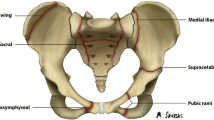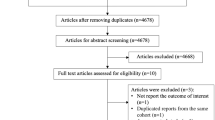Abstract
Summary
The study assessed the recent secular trend in the incidence of low-trauma knee fractures among older Finns in the years 1970–2006. The clear rise in women’s fracture incidence from early 1970s until the late 1990s was followed by a declining fracture rate. Exact reasons for the decline are unknown, but a cohort effect toward a healthier female population with improved functionality and reduced risk of injurious slips, trips and falls could partly explain the phenomenon.
Introduction
Although low-trauma fractures of elderly adults have been recognized as a major public health concern in modern societies with aging populations, fresh nationwide information on their secular trends is sparse.
Methods
We determined the current trend in the number and incidence (per 100,000 persons) of low-trauma knee fractures among elderly people in Finland, an EU country with a well-defined white population of 5.3 million, by taking into account all persons 60 years of age or older who were admitted to our hospitals for primary treatment of such fractures from 1970 to 2006.
Results
The number and incidence of low-trauma knee fractures among 60-year-old or older Finnish women sharply rose between 1970 and 1997, from 218 (number) and 55 (incidence) in 1970 to 733 and 124 in 1997. However, thereafter both the number and incidence of fractures have continuously declined so that there were only 626 fractures in these women in 2006 (incidence 94). In the age-adjusted fracture incidence, the findings were similar. During 1970–1997, the age-adjusted incidence of low-trauma knee fractures in our elderly women clearly rose (from 60 to 118), but thereafter, this incidence declined to 85 in 2006. In men, the fracture incidence did not show consistent trend changes over time (30 in 1970 and 36 in 2006).
Conclusions
The sharp rise in the incidence of low-trauma knee fractures in Finnish elderly women from early 1970s until late 1990s has been followed by a declining fracture rate. Exact reasons for this are unknown, but a cohort effect toward a healthier aging female population with improved functional ability and reduced risk of injurious slips, trips and falls cannot be excluded.

Similar content being viewed by others
References
Kannus P, Niemi S, Parkkari J, Palvanen M, Vuori I, Järvinen M (1999) Hip fractures in Finland between 1970 and 1997 and prediction for the future. Lancet 353:802–805
Cummings SR, Melton LJ III (2002) Epidemiology and outcomes of osteoporotic fractures. Lancet 359:1761–1767
Gates S, Lamb SE, Fisher JD, Cooke MW, Carter YH (2008) Multifactorial assessment and targeted intervention for preventing falls and injuries among older people in community and emergency care settings: systematic review and meta-analysis. BMJ 336:130–133
Kannus P, Sievänen H, Palvanen M, Järvinen T, Parkkari J (2005) Prevention of falls and consequent injuries in elderly people. Lancet 366:1885–1993
Kannus P, Niemi S, Parkkari J, Palvanen M, Vuori I, Jarvinen M (2006) Nationwide decline in incidence of hip fracture. J Bone Miner Res 21:1836–1838
Guggenbuhl P, Meadeb J, Chales G (2005) Osteoporotic fractures of the proximal humerus, pelvis and ankle: epidemiology and diagnosis. J Bone Spine 72:372–375
Delmas PD, Marin F, Marcus R, Misurski DA, Mitlak BH (2007) Beyond hip: importance of other nonspinal fractures. Am J Med 120:381–387
Seeley DG, Kelsey J, Jergas M, Nevitt MC for the Study of Osteoporotic Fractures Research Group. Predictors of ankle and foot fractures in older women. J Bone Miner Res 1996;11:1347–1355
Hasselman CT, Vogt MT, Stone KL, Cauley JA, Conti SF (2003) Foot and ankle fractures in elderly white women. Incidence and risk factors. J Bone Joint Surg 85-A:820–824
Kannus P, Niemi S, Palvanen M, Parkkari J, Pasanen M, Järvinen M, Vuori I (2001) Continuously rising problem of osteoporotic knee fractures in elderly women: nationwide statistics in Finland in 1970–1999 and predictions until the year 2030. Bone 29:419–423
Keskimäki I, Aro S (1991) Accuracy of data on diagnosis, procedures and accidents in the Finnish hospital discharge register. Int J Health Sci 2:15–21
Luthje P, Nurmi I, Kataja M, Heliövaara M, Santavirta S (1995) Incidence of pelvic fractures in Finland in 1988. Acta Orthop Scand 66:245–248
Sund R, Nurmi-Luthje I, Luthje P, Tanninen S, Narinen A, Keskimäki I (2007) Comparing properties of audit data and routinely collected register data in case of performance assessment of hip fracture treatment in Finland. Methods Inf Med 46:558–566
Mattila V, Sillanpää P, Iivonen T, Parkkari J, Kannus P, Pihlajamäki H (2007) Coverage and accuracy of diagnosis of serious knee injury in a Finnish National Hospital Discharge Register. Injury submitted for publication
Official Statistics of Finland (2007a) Structure of population and vital statistics: whole country and provinces, 1970–2006. Statistics Finland. Helsinki, Finland
Official Statistics of Finland (2007b) Population projections by municipalities 2007–2030. Statistics Finland. Helsinki, Finland
Giversen IM (2006) Time trends of age-adjusted incidence rates of first hip fractures: a register-based study among older people in Viborg County, Denmark, 1987–1997. Osteoporos Int 17:552–564
Nymark T, Lauritsen JM, Ovesen O, Röck ND, Jeune B (2006) Decreasing incidence of hip fracture in the Funen County, Denmark. Acta Orthop Scand 77:109–113
Jaglal S (2007) Letter to the editor. Falling hip fracture rates. J Bone Miner Res 22:1098
Sulander TT, Rahkonen OJ, Uutela AK (2003) Functional ability in the elderly Finnish population: time period differences and associations, 1985–1999. Scand J Public Health 31:100–106
Acknowledgments
This study was funded by the Competitive Research Funding of the Pirkanmaa Hospital District, Tampere, Finland, and, the Juho Vainio Foundation, the Paulo Foundation, and the Finnish Ministry of Social Affairs and Health, Helsinki, Finland.
Conflicts of interest
None.
Author information
Authors and Affiliations
Corresponding author
Rights and permissions
About this article
Cite this article
Kannus, P., Niemi, S., Parkkari, J. et al. Declining incidence of low-trauma knee fractures in elderly women: nationwide statistics in Finland between 1970 and 2006. Osteoporos Int 20, 43–46 (2009). https://doi.org/10.1007/s00198-008-0625-z
Received:
Accepted:
Published:
Issue Date:
DOI: https://doi.org/10.1007/s00198-008-0625-z




